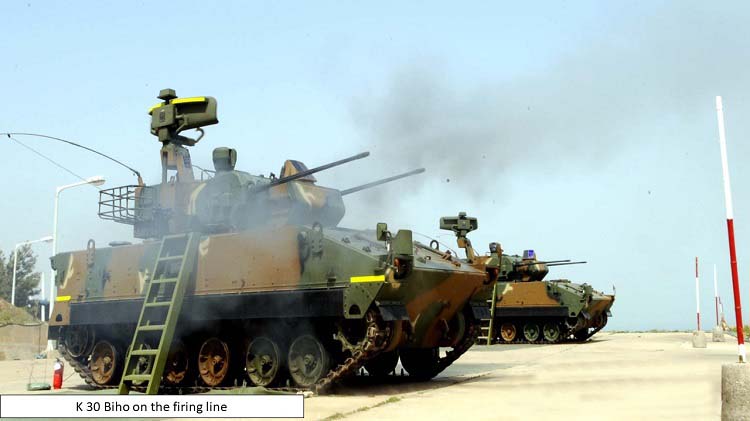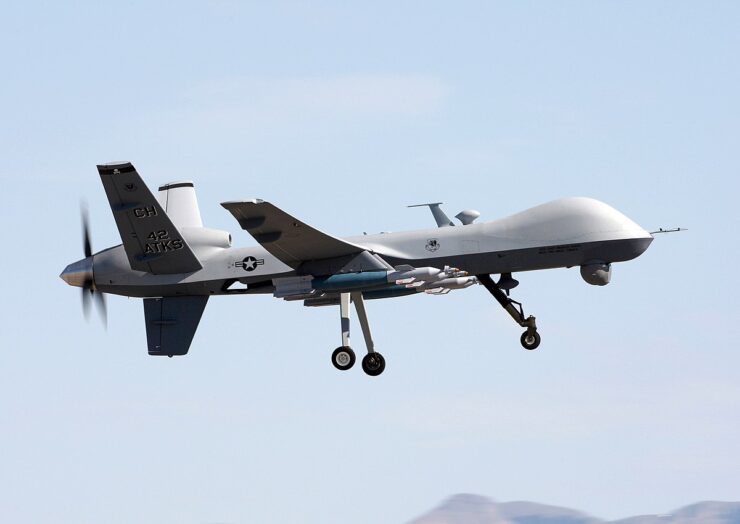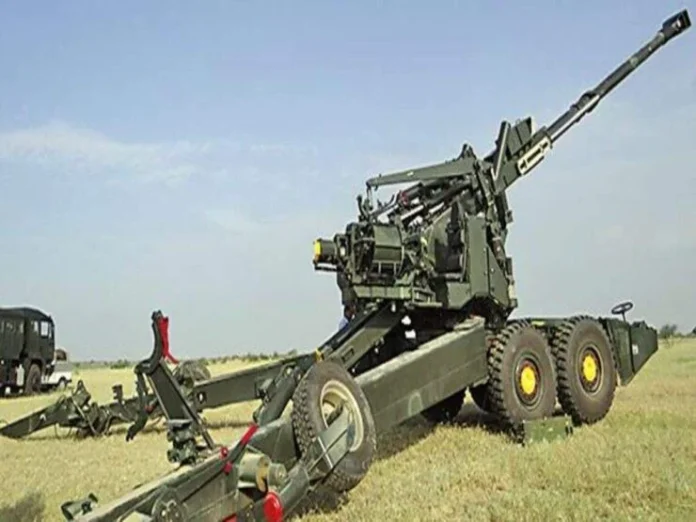Wars have changed, and this is especially true for the Indian Army. In previous wars, its primary aerial threat was the enemy air force, which was tackled by the Indian Air Force and the army’s air defence units. In both the 1965 and 1971 Wars, after the IAF had neutralised the Pakistan Air Force and ensured air supremacy over the Indian subcontinent, the Indian Army’s strike formations were able to blast through the Pakistan Army’s frontal defences on the international border. Today, the threat has expanded to include cruise missiles, long-range artillery, attack helicopters and Unmanned Aerial Vehicles or drones (both spy and attack versions). In the future, we are likely to see hypersonic weapons and tactical ballistic missiles in this mix. The arrival of unconventional warfare has added to the complexity of Army Air Defence (AAD).
In the backdrop of the multiple threats facing the army, the AAD has evolved into a complete system that includes missiles, anti-aircraft guns, radars, fire control devices and surveillance drones. Plus, modern armies have a battle management system that integrates these subsystems. The possibility of a collusive two-front war has forced India to rapidly modernise its Soviet-era weaponry. This threat is also dictating how the Indian Army should invest its research and development funds.
Air Defence For Mechanised Forces
An army on the move is vulnerable to air threats – mainly from the adversary’s air force. From attack aircraft, bombers and helicopters in the previous wars, the air threat component has increased vastly and today also includes stealth aircraft, cruise missiles, electronic warfare weapons and anti-radiation weapons.

In order to counter the type of air threat that has been evolving, the Indian Army’s arsenal will have to be all-weather all-terrain capable and enabled for a 24×7 operation cycle. Various components of air defence need to be integrated on a theatre grid. Such defences must be capable of delivering successive and seamless fire at air threat vehicles, shifting from weapon to weapon and covering the entire spectrum of heights and distances without gaps. This barrage must commence as soon as the threat vehicles are detected at maximum possible ranges and must continue seamlessly right up to the end game at the terminal end of deployment.
Currently there are large gaps in India’s battlefield air defence in both the guns and missiles categories. In the guns category, the current weapons are the ZSU 234B1 Schilka mobile gun system and the Tunguska M1 air defence gun-missile system, both of Russian origin. The Schilka system is early 1970s vintage, and has had an upgrade in 2014. As happens too often in India’s defence forces, decades go by without new acquisitions and upgrades, and air defence too suffered the same fate.
SOURCING: On May 10, 2019, it was reported the Indian Army had selected the South Korean made Hanwha K-30 Biho (Flying Tiger), a highly mobile short-range ground based air defence (GBAD) weapon system that will provide close support for its forward units. Its range of 17 km and very high rate of fire of 1,200 rounds per minute create a high deterrent effect besides a high kill probability. However, this deal has got stuck in India’s procurement bureaucracy following objections from Russia.
Meanwhile, the Army is looking at major progress in the next few months in terms of deals and trials. These include additional indigenous Akash Surface to Air Missile (SAM) systems, the under development Medium Range Surface to Air Missile (MRSAM) and the Igla-S Very Short Range Air Defence (VSHORAD) system (6 km range) from Russia.
The Army has two Akash regiments in service and negotiations are on for two more. Contract is expected to be concluded by January 2022. With a 60 kg warhead, it is capable of striking down fighter jets and drones at a distance of around 25 km, and can be fired from both tracked and wheeled platforms for greater mobility.
In addition, the Army variant of the MRSAM, being jointly developed by the Defence Research and Development Organisation (DRDO) and Israel Aerospace Industries (IAI), is nearing induction with the final stage of trials scheduled to be held in the coming months.
Also, the Army has issued a Request For Proposal (RFP) for 220 air defence guns and 1,41,576 rounds of ammunition to be procured under the Buy and Make category. Of these, 25 guns and 44,440 rounds of ammunition would be procured under the Buy portion and the remaining under the Make portion of the contract.
Meanwhile, full backing needs to be given to the indigenous Quick Reaction Surface-to-Air Missile (QRSAM-I) for the mechanised forces. A product of the DRDO and Bharat Electronics Limited, it is an all-weather, all-terrain surface-to-air missile equipped with electronic counter measures against jamming by aircraft radars. The missile can be mounted on a truck and is stored in a canister. The QRSAM uses solid-fuel propellant and has a range of 25-30 km. The QRSAM-I is a good example of the Narendra Modi government cancelling a global acquisition programme in favour of an Indian one.
Unsafe At Any Height: Vietnamese Experience
The Vietnamese organised what was perhaps the most sophisticated and effective anti-aircraft defence in the history of warfare. “It was a multi-level, dynamically integrated defence that included radar warning systems, MiG jet fighters, SAMs, AAA of various calibres and small arms fire,” writes Vietnamese General Van Tien in the book American Failure.
As soon as US aircraft intruded into their airspace, Vietnamese radars vectored MiG fighters to intercept the attacking bombers and their fighter escorts. The information was also passed on to SAM command centres.
In order to counter the SAMs, US aircraft started using electronic countermeasure devices on their wingtips. This reduced the planes’ manoeuvrability and made them more vulnerable to MiG attacks.
“When a SAM was actually coming at them, pilots performed a tight turning dive to outmanoeuvre the missile, but this tactic had the undesirable effect of bringing them down again into the range of AAA,” writes Robert Dorr in Air War Hanoi.
Between 1964 and 1973 the Vietnamese anti-aircraft units alone downed 740 US Air Force fighter aircraft. They also shot down hundreds of helicopters, several F-111 fighter bombers and 15 irreplaceable B-52 strategic bombers. The B-52s were lost despite the use of electronic jamming aircraft, defence suppression aircraft and fighter escorts. Interestingly, after the Vietnamese ran out of SAMs the USAF did not lose any more B-52s.
This system created an environment in which aircraft tactics designed to escape one type of threat brought the plane under threat from another layer of the system. The lesson for India is that the moment an enemy aerial asset enters the battle zone, it should be engaged.
A Rand Corporation report, titled ‘Future Air and Missile Threats’, suggests the Vietnamese layered air defence tactics are still relevant. “Because cruise missiles and UAVs are universal threats, short-range air defences will also be needed to defend against weapons that make it through the outer air defense layers. Where manned aircraft are likely to be present, short-range systems can degrade the enemy’s ability to attack by forcing enemy ground attack aircraft to higher altitudes or by denying the enemy information gathered by UAVs.”
Air Cover
An army without air cover is a sitting duck for enemy forces. In order to dominate the modern warzone, the army must have a sufficient number of air assets that commanders can throw into battle when and where they want. These air assets – including observation aircraft, attack and transport helicopters, and fixed wing ground attack jets – that are directly under the army’s command are collectively known as Army Aviation.
The primary mission of Army Aviation is reconnaissance and observation, but its role profile also includes combat, combat support, air traffic control and logistics. More than ever, in the 21st century, where wars are going to be of high intensity and short duration, Army Aviation will play a critical role by removing the element of uncertainty. Quite simply, if the army has its own air wing, it can undertake offensive operations without the risk of the air force arriving late into the combat zone.
According to the Comptroller and Auditor General of India, although the Corps was created with the main objective of contributing to battlefield success by providing guidance to field commanders in applying decisive combat powers, it is plagued with 32 percent deficiency vis-a-vis its authorised fleet strength.
The US Army has under its operational command 3,510 helicopters (of which 839 are of the attack variety), 256 fixed wing aircraft and 450 advanced drones. By the time the Cold War ended in 1990, the Russian Army could call into battle as many 2,135 fixed wing attack aircraft and 4,300 helicopters (including 1,420 Mi-24 attack helos).
China’s PLA has nearly 700 helicopters and even the Pakistan Army, which survives on foreign grants, has 260 choppers.
In this backdrop, the Army Aviation assets are inadequate for the size of the Indian Army and the tasks it is required to perform. Its expansion, therefore, needs to be undertaken on a war footing. Army Aviation should possess a mix of light fixed-wing aircraft and all categories of helicopters, including attack helicopters/gunships for various roles like reconnaissance, surveillance, combat fire support, airborne command posts, combat service support, special operations, and logistics.
SOURCING: The Army has a requirement of 394 light utility helicopters. Some of this requirement will be met by imports, most likely from Kamov. The Army is also planning to acquire the Light Combat Helicopter, which is under development by HAL, to meet its requirements for an attack helicopter that can operate at high altitudes (16,300 feet) to fit into an anti-armour and anti-infantry role.
The Army also requires adequate numbers of tactical battle support helicopters such as the HAL Rudra. In a major breakthrough in 2017 the government approved the army’s purchase of six US-built Apache attack helicopters in a deal worth $655 million or about Rs 4,170 crore. The Apaches will be deployed on the western front in support of tank formations. The deal will see the Army Aviation Corps operating its own attack helicopters for the first time and ending a long-standing monopoly of the air force. However, just six Apaches would have limited operational value. Attack helicopters have been on the army’s wish list for several years, but the IAF objected to the plan. The army says it requires more attack helicopters as it had moved a case to buy 39 Apaches.
The Corps will also require choppers for Special Operations (for para commandos), helicopter-borne early-warning (for employing electronic warfare) and light fixed-wing aircraft (for surveillance and communication tasks). These projects must be pursued vigorously so that they start delivering reliable aerial assets to the Army at the earliest.
Unmanned Aerial Vehicles
While spy satellites can give you a strategic picture, their ability to sniff out secrets can be hampered by external factors. For instance, some satellites may be limited to a certain number of passes per day over a specific area. Cloud cover can impact others. Plus, the orbit of each satellite is available on a simple mobile phone app, allowing the enemy to hide his assets and mask his intentions just as your satellite makes an overhead pass. That’s why drones are becoming an integral part of warfare.

Unlike satellites, drones can supply immediate tactical intelligence. For instance, drones can detect what’s hiding behind a hill; enemy movement in a cornfield; or a convoy moving through a forest at night. UAVs are therefore critical for intelligence gathering, especially in the heat of combat. They need to be inducted in adequate numbers for surveillance and precision attack operations in both peace and war.
SOURCING: UAVs are relatively slow-moving, low-tech aircraft that can easily be indigenised. The Rs 1,500 crore Rustom UAV is currently being developed by the DRDO’s Aeronautical Development Establishment along with partners HAL and Bharat Electronics Ltd. While details are sketchy and the latest prototype crashed earlier this year, it is likely to have artificial intelligence based solutions for change detection to carry out surveillance at high altitude border areas.
Even as the focus is on intelligence gathering drones like the Rustom, more pressing is the requirement of ‘mule’ or load-carrying drones that can transport up to 50 kg in high altitude areas – both in friendly and hostile territory. Also required are loiter munitions drones – UAVs designed to engage beyond line-of-sight ground targets with an explosive warhead. Loiter munitions are meant to provide the infantry the capability to strike while carrying out surveillance. Anti-drone solutions to shoot down the enemy’s UAVs need to be developed for both war and peacetime purposes. These weapons can immediately detect a drone being used by the enemy and shoot it down quickly.
Such specialised drones should be capable of operating up to 20,000 feet. An endurance of approximately 6 to 8 hours is desired for these drones so as to achieve a minimum 10 km flight range.
The Army Design Bureau, the facilitator for research and development efforts and initiation of procurements of weapons and equipment required by the Indian Army, has roped in the DRDO, academia, defence public sector undertakings, Ordnance Factory Boards, and private industry to develop high quality drones.
Conclusion
It takes a long time to develop and buy weapons, especially in the area of air defence. This means the Indian Army must start today to defend itself against the threats of tomorrow.
Secondly, the globalised economy allows even dirt poor countries like Pakistan to acquire sophisticated weapons at low cost. This means the Indian Army’s vast quantitative – and relatively modest qualitative – advantage can be neutralised if India doesn’t keep modernising its forces. This is an endless loop, and in fact India must treat this as an endurance race. With its much larger economy, it can match China while leading Pakistan into an unaffordable arms race that breaks the back of the Pakistani economy.
Thirdly, no single system fielded by any of the services can defend all assets in the theatre from all likely threats. Translation: The Army alone cannot do everything. By creating operational synergies with the IAF and Indian Navy, the Army can get more bangs for the buck.
–The writer is a globally cited defence analyst. His work has been published by leading think tanks, and quoted extensively in books on diplomacy, counter terrorism, warfare and economic development. The views expressed are personal and do not necessarily reflect the views of Raksha Anirveda
–The writer is a globally cited defence analyst based in New Zealand. The views expressed are of the writer and do not necessarily reflect the views of Raksha Anirveda














